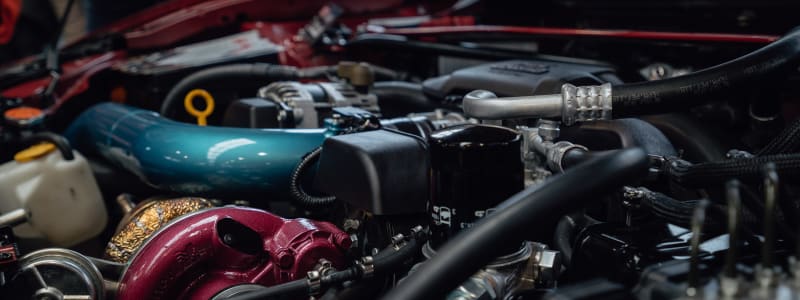
These days, a turbocharger is standard for diesel and gasoline engines, but most car owners do not really know what features a turbo charger has and what they should consider when driving. That is why we have collected the most important information about turbochargers, so that you know exactly how they work, what they do and how you can maintain your turbocharger in the best way.
What does a turbocharger do?
A turbocharger increases the performance of an internal combustion engine. An engine gets its power from the combustion of the fuel-air mixture. Therefore, the performance of the engine is also increased when it receives more of this mixture. To increase the cubic capacity, the cylinder volume is often increased, or an additional cylinder is added. The same condition can be achieved by injecting more air into the existing cylinders. That is exactly what the turbocharger is responsible for.
How does a turbocharger work?
An engine without a turbocharger only draws in fresh air and feeds it into the combustion process. An engine with a turbocharger will additionally use the exhaust air. This ensures a higher engine performance with lower fuel consumption and better emission levels.
A turbocharger usually consists of an exhaust gas turbine and a turbo compressor, which are mounted on a common shaft. The gas flows from the outside to the inside of the turbine while it flows from the inside to the outside of the compressor. First, the exhaust air is accelerated through the turbine and directed into the compressor. In the compressor, the air is then compressed.
This compressed air is subsequently passed through an air cooler to cool it sufficiently enough. This is especially important to reduce emissions and increase the engine's performance. After this, the air is directed into the cylinders and drives the pistions together with the injected fuel. As a result, acceleration is boosted.
What is a twin-turbo?
Many turbocharged engines have two turbochargers instead of one large turbo. The turbochargers are slightly smaller and share the exhaust flow of the cylinders. That means that in a six-cylinder, each turbocharger uses the exhaust gases of three cylinders each.
A big advantage of two turbochargers is that they have a lower mass inertia. This means that a large turbocharger needs more energy and thus higher engine speeds to build up a useful boost pressure. This is not the case with two turbochargers as these can promote sufficiently compressed air even at lower speeds. In addition, they can provide enough power even at a very high speed.
What is a turbo lag
Turbo lag refers to the lack of power that a turbocharger has until a certain speed is reached. This does not happen too often these days, which is why the term refers primarily to turbochargers of the 90s.
How long does a turbo last?
As a rule, turbochargers should follow the life of the engine and not be replaced before. However, the life of the turbo depends on many different factors, so it may still be necessary in some cases, to change the turbo or to get it repaired.
How can you prevent damages of the turbo?
From the quality garages in our network we know that most of the damage to the turbocharger is caused by things that could be avoided through regular maintenance work and car services. It is therefore advisable to observe the oil change intervals, to have the oil filter system regularly maintained, to check the oil pressure and to clean the air filter system. This ensures that your turbocharger will remain functional for as long as possible and that it does not have to be repaired or replaced at an early stage.
What are the most common damages?
One of the most common damages to a turbo is the intrusion of debris into the turbine or compressor of the turbocharger. Also dirt particles in the oil can damage the turbo and cause some errors.
In addition, a lack of oil in the engine can lead to damages of the engine and the turbocharger, which can cause it to lose functionality and must be completely replaced. Excessive exhaust gas temperature can damage your turbocharger as well. Most elevated temperatures are triggered by errors in the ignition or fuel injection system.
How do I drive with a turbocharger?
A turbocharger is exposed to very high temperatures because it uses exhaust gas energy. A normal gasoline engine can get up to 1,000 degrees hot. If the car is parked after a long full-throttle drive, especially after a long drive on the highway, a build-up of heat can form in the engine compartment. This happens because of the sudden lack of wind, to which the turbo can not adjust. This can significantly shorten the life expectancy of the turbocharger and should therefore be avoided.
Therefore, strong temperature changes should always be avoided. If you have driven on the highway for an extended period of time, you should end up driving a little slower for a part of the route and not park your car immediately after leaving the motorway. This allows the turbo to adapt to the high temperature with less cooling.
At the same time you should make sure to avoid a big temperature difference at the beginning of your ride. Therefore, it is recommended to warm the turbo and the engine before you accelerate fully.






